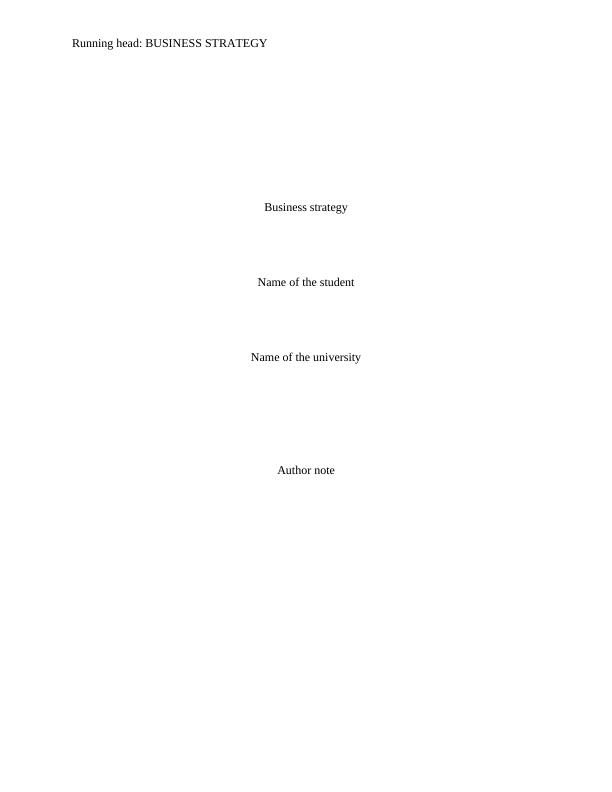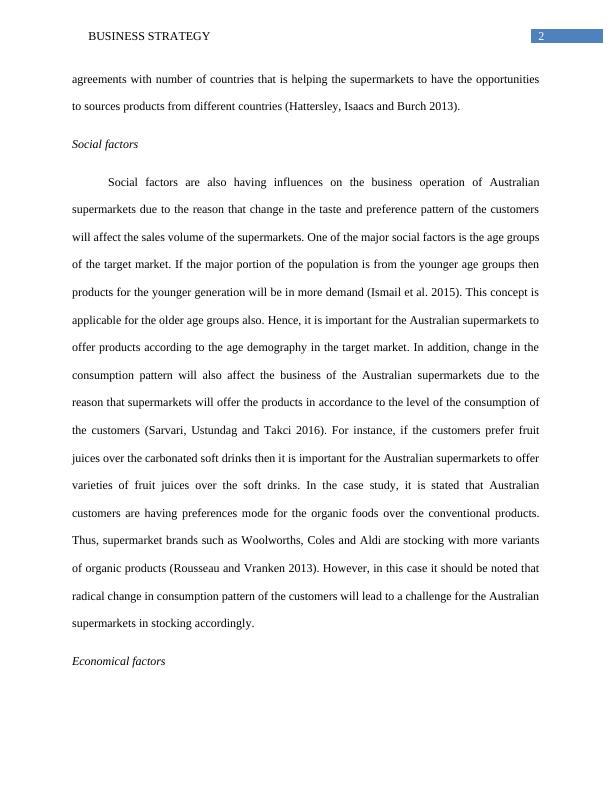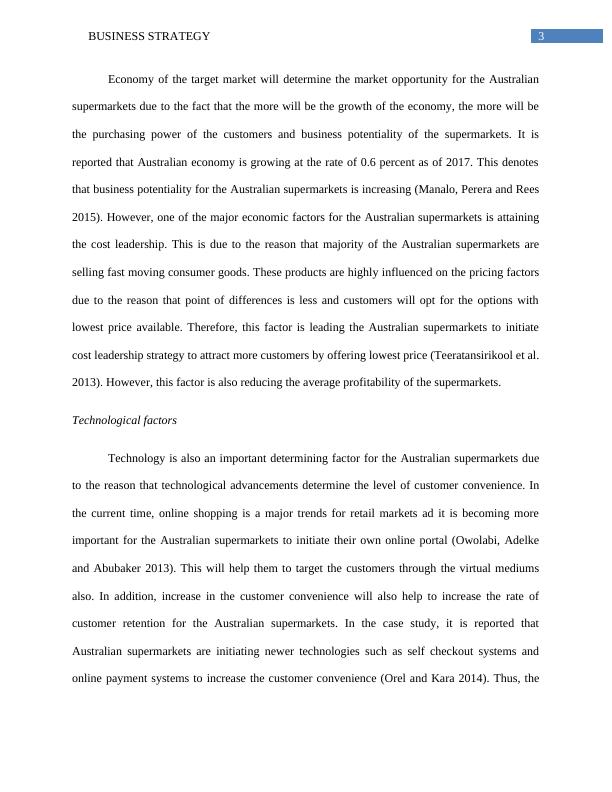PEST Analysis and Porter's Five Forces Analysis of Australian Supermarket Industry
Added on 2023-06-07
12 Pages3328 Words477 Views
Running head: BUSINESS STRATEGY
Business strategy
Name of the student
Name of the university
Author note
Business strategy
Name of the student
Name of the university
Author note

1BUSINESS STRATEGY
Question: 1
There are number of macro environmental factors that are influencing the Australian
supermarket industry. These influences are having more positive as well as negative impacts on
the Australian supermarkets. PEST analysis will be done in order to understand these factors.
Political factors
Australian political economy is relatively stable and having favorable impact on the
business organizations. In addition, the pro business approach of the government is also having
favorable impacts on the retail brands (Vandevelde 2017). It is reported that recently the foreign
ownership is permitted in the retail sectors of Australia. This is having both positive and negative
impacts on the Australian supermarkets due to the reason that permitting the foreign leadership is
attracting new global players in the market that is increasing the competition in the market. On
the other hand, having the more competition in the market is helping the consumers in having the
access to more options. Existing Australian brands such as Coles and Woolworths are facing
more competition due to the entrance of the foreign brands and this is affecting their profitability
(Davey and Richards 2013).
In addition, the political stability in Australia is also encouraging the foreign retail brands
to enter in the Australian market. However, one of the major negative factors in relation to the
political environment of Australia is different rules and regulations in different states. It is
identified that New South Wales and Victoria are having different sets of regulations regarding
the retail industry (Hughes et al. 2013). This may have negative impacts on the existing
supermarkets in the Australian market. It should also be noted that Australia is having free trade
Question: 1
There are number of macro environmental factors that are influencing the Australian
supermarket industry. These influences are having more positive as well as negative impacts on
the Australian supermarkets. PEST analysis will be done in order to understand these factors.
Political factors
Australian political economy is relatively stable and having favorable impact on the
business organizations. In addition, the pro business approach of the government is also having
favorable impacts on the retail brands (Vandevelde 2017). It is reported that recently the foreign
ownership is permitted in the retail sectors of Australia. This is having both positive and negative
impacts on the Australian supermarkets due to the reason that permitting the foreign leadership is
attracting new global players in the market that is increasing the competition in the market. On
the other hand, having the more competition in the market is helping the consumers in having the
access to more options. Existing Australian brands such as Coles and Woolworths are facing
more competition due to the entrance of the foreign brands and this is affecting their profitability
(Davey and Richards 2013).
In addition, the political stability in Australia is also encouraging the foreign retail brands
to enter in the Australian market. However, one of the major negative factors in relation to the
political environment of Australia is different rules and regulations in different states. It is
identified that New South Wales and Victoria are having different sets of regulations regarding
the retail industry (Hughes et al. 2013). This may have negative impacts on the existing
supermarkets in the Australian market. It should also be noted that Australia is having free trade

2BUSINESS STRATEGY
agreements with number of countries that is helping the supermarkets to have the opportunities
to sources products from different countries (Hattersley, Isaacs and Burch 2013).
Social factors
Social factors are also having influences on the business operation of Australian
supermarkets due to the reason that change in the taste and preference pattern of the customers
will affect the sales volume of the supermarkets. One of the major social factors is the age groups
of the target market. If the major portion of the population is from the younger age groups then
products for the younger generation will be in more demand (Ismail et al. 2015). This concept is
applicable for the older age groups also. Hence, it is important for the Australian supermarkets to
offer products according to the age demography in the target market. In addition, change in the
consumption pattern will also affect the business of the Australian supermarkets due to the
reason that supermarkets will offer the products in accordance to the level of the consumption of
the customers (Sarvari, Ustundag and Takci 2016). For instance, if the customers prefer fruit
juices over the carbonated soft drinks then it is important for the Australian supermarkets to offer
varieties of fruit juices over the soft drinks. In the case study, it is stated that Australian
customers are having preferences mode for the organic foods over the conventional products.
Thus, supermarket brands such as Woolworths, Coles and Aldi are stocking with more variants
of organic products (Rousseau and Vranken 2013). However, in this case it should be noted that
radical change in consumption pattern of the customers will lead to a challenge for the Australian
supermarkets in stocking accordingly.
Economical factors
agreements with number of countries that is helping the supermarkets to have the opportunities
to sources products from different countries (Hattersley, Isaacs and Burch 2013).
Social factors
Social factors are also having influences on the business operation of Australian
supermarkets due to the reason that change in the taste and preference pattern of the customers
will affect the sales volume of the supermarkets. One of the major social factors is the age groups
of the target market. If the major portion of the population is from the younger age groups then
products for the younger generation will be in more demand (Ismail et al. 2015). This concept is
applicable for the older age groups also. Hence, it is important for the Australian supermarkets to
offer products according to the age demography in the target market. In addition, change in the
consumption pattern will also affect the business of the Australian supermarkets due to the
reason that supermarkets will offer the products in accordance to the level of the consumption of
the customers (Sarvari, Ustundag and Takci 2016). For instance, if the customers prefer fruit
juices over the carbonated soft drinks then it is important for the Australian supermarkets to offer
varieties of fruit juices over the soft drinks. In the case study, it is stated that Australian
customers are having preferences mode for the organic foods over the conventional products.
Thus, supermarket brands such as Woolworths, Coles and Aldi are stocking with more variants
of organic products (Rousseau and Vranken 2013). However, in this case it should be noted that
radical change in consumption pattern of the customers will lead to a challenge for the Australian
supermarkets in stocking accordingly.
Economical factors

3BUSINESS STRATEGY
Economy of the target market will determine the market opportunity for the Australian
supermarkets due to the fact that the more will be the growth of the economy, the more will be
the purchasing power of the customers and business potentiality of the supermarkets. It is
reported that Australian economy is growing at the rate of 0.6 percent as of 2017. This denotes
that business potentiality for the Australian supermarkets is increasing (Manalo, Perera and Rees
2015). However, one of the major economic factors for the Australian supermarkets is attaining
the cost leadership. This is due to the reason that majority of the Australian supermarkets are
selling fast moving consumer goods. These products are highly influenced on the pricing factors
due to the reason that point of differences is less and customers will opt for the options with
lowest price available. Therefore, this factor is leading the Australian supermarkets to initiate
cost leadership strategy to attract more customers by offering lowest price (Teeratansirikool et al.
2013). However, this factor is also reducing the average profitability of the supermarkets.
Technological factors
Technology is also an important determining factor for the Australian supermarkets due
to the reason that technological advancements determine the level of customer convenience. In
the current time, online shopping is a major trends for retail markets ad it is becoming more
important for the Australian supermarkets to initiate their own online portal (Owolabi, Adelke
and Abubaker 2013). This will help them to target the customers through the virtual mediums
also. In addition, increase in the customer convenience will also help to increase the rate of
customer retention for the Australian supermarkets. In the case study, it is reported that
Australian supermarkets are initiating newer technologies such as self checkout systems and
online payment systems to increase the customer convenience (Orel and Kara 2014). Thus, the
Economy of the target market will determine the market opportunity for the Australian
supermarkets due to the fact that the more will be the growth of the economy, the more will be
the purchasing power of the customers and business potentiality of the supermarkets. It is
reported that Australian economy is growing at the rate of 0.6 percent as of 2017. This denotes
that business potentiality for the Australian supermarkets is increasing (Manalo, Perera and Rees
2015). However, one of the major economic factors for the Australian supermarkets is attaining
the cost leadership. This is due to the reason that majority of the Australian supermarkets are
selling fast moving consumer goods. These products are highly influenced on the pricing factors
due to the reason that point of differences is less and customers will opt for the options with
lowest price available. Therefore, this factor is leading the Australian supermarkets to initiate
cost leadership strategy to attract more customers by offering lowest price (Teeratansirikool et al.
2013). However, this factor is also reducing the average profitability of the supermarkets.
Technological factors
Technology is also an important determining factor for the Australian supermarkets due
to the reason that technological advancements determine the level of customer convenience. In
the current time, online shopping is a major trends for retail markets ad it is becoming more
important for the Australian supermarkets to initiate their own online portal (Owolabi, Adelke
and Abubaker 2013). This will help them to target the customers through the virtual mediums
also. In addition, increase in the customer convenience will also help to increase the rate of
customer retention for the Australian supermarkets. In the case study, it is reported that
Australian supermarkets are initiating newer technologies such as self checkout systems and
online payment systems to increase the customer convenience (Orel and Kara 2014). Thus, the

End of preview
Want to access all the pages? Upload your documents or become a member.
Related Documents
Analysis of Micro and Macro Environmental Factorslg...
|7
|967
|205
Boost Juice Bar: International Strategy for Entering China and Brazillg...
|7
|1704
|129
Strategic Analysis for Boost Juice, Qantas Airlines, Coles and Harvey Normanlg...
|11
|3107
|223
Foreign Market Entry Strategy of Daily Juice in Indialg...
|18
|4227
|139
Boost juice marketing strategies for the Australian marketlg...
|12
|2282
|461
Market Potentiality of Grove Juice in India: PEST and Porter Analysislg...
|20
|4747
|100